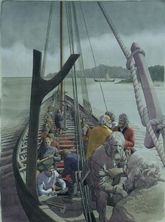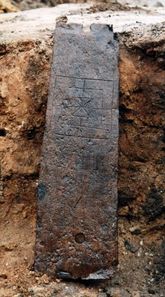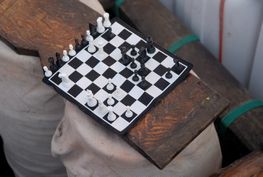Holumenn
The ordinary crew members on board warships in the Viking Age were called holumenn and their most important task was to sail the ship.
The Norwegian Gulating Law, dating from the 12th and 13th century, relates that the King would appoint a coxswain. The coxswain would then select the crew – as a rule these were young, unmarried men. If they did not turn up, of if they refused to sail with the ship, they were issued with a fine. In cases where there were not enough young farm hands, the farmers who employed the workmen had to join the ship for the voyage. Everybody was paid and, according to the Norwegian law text, the payment was 1 øre per month.
Watches on board
The crew formed watches. The watchs Bergvordr by the oars, Rávordr by the sail, Festavordr by the mooring on land and Strengvordr by the cable when the ship lay at anchor. All of the watches were to be manned day and night.
The tasks were to trim the sail, to keep the ship empty of water, to keep watch and steer the rudder. The helmsman was also called Stjórnari.
There was also a lookout in the bow section of the vessel. In Viking times he was called Stafnbúaror Sundvordr. Together with the skipper and the coxswains the lookout had a responsible position on board, especially when sailing along the coast where it was important to keep an eye out for distinctive landmarks. The lookout had to have a strong voice so that he could shout his observations to the rest of the ship and to the skipper, who stood either by the mast or at the stern of the ship. According to Helge Hundingsbane's story warships had a special watch for looking out for the enemy.
Personal equipment
Icelandic sources indicate that the crew brought along some kind of sleeping bag. There were no berths – instead the spaces between each thwart constituted their sleeping places. The sleeping bag was called a Húdfat; it was a large hide stitched together along the sides and with room for two persons.
Sea chests were part of the general equipment on warships and these could probably be moved around. Eyrbyggernes Saga relates that the men occupying a rum (or section of the ship) had to share a chest for storing their supplies, clothes and weapons.
Women on board
Normally there were no women on board ships in the Viking Age. But sometimes there were women slaves or prisoners of war on board, or women of high rank were carried as passengers. The fact that the presence on the ships of women was quite exceptional is evident from a few written sources. These recount that the women had to be protected against various dangers and from rain.
Fact: The Icelandic Flateyjarbok from the 14th century relates how Leif and his men, during a voyage to Østerø on the Faroe Islands, all were soaked because they had to make sure that Thora remained dry.
Life on board
Today it is hard to tell what the crew did on board the ships when not on duty. In the rich ship burial of Oseberg and on a reused deck plank found in Aarhus a gaming board has been found which could be used for the games of morris and nefatavl. Many graves also contain gaming pieces and dice made of glass, bone, antler, tooth or horn. On the Isle of Lewis 93 chessmen mede of walrus ivory were found in 1831. The sagas speak of games such as halatavl, nefatavl and chess. Though not stating the rules of the games the sagas indicate that the ability to play, for example, chess was part of a noble education. For example a certain man Grymer who was courting a beautiful maid had to prove his worth through weapons exercises, climbing of icebergs, performing trials of strength, play chess well, interpret the stars and other sports.
By: Louise Kæmpe Henriksen
Sleeping blanket used on trading ships
We also know of a so-called Sørya, which was a sleeping blanket, woven of wool. One side was in plain weave, on the other, small wads of raw wool were tired so that the blanket looked like a sheep skin. Rya blankets have been found at Birka in Sweden and in Heynes on Iceland. Both are dated to the 10th-12th centuries. The Sørya could withstand getting wet and was easier to dry than the skin sleeping bag. But it also took up more room. It was therefore probably more likely to be found on ships having fewer men on board, such as merchant ships, cargo ships and fishing boats.


